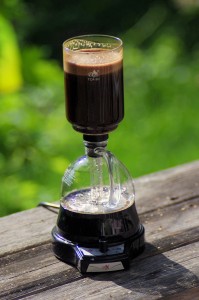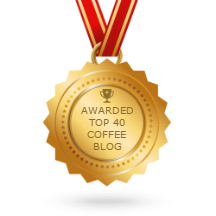 This is as much a story about social media as a coffee brewer review. I first read about the Diguo TCA-C3 Siphon in a post by its Chinese manufacturer on LinkedIn. I was instantly enthused and invited them to CoffeeCON 2013. Next thing I knew they brought the spanking new brewer to CoffeeCON 2013, where is was a definite attention getter. The Diguo TCA-C3 is a glass siphon that makes three five-ounce cups of coffee. This is about one cup short of idea, but it’s perfect for a couple of cups of coffee.
This is as much a story about social media as a coffee brewer review. I first read about the Diguo TCA-C3 Siphon in a post by its Chinese manufacturer on LinkedIn. I was instantly enthused and invited them to CoffeeCON 2013. Next thing I knew they brought the spanking new brewer to CoffeeCON 2013, where is was a definite attention getter. The Diguo TCA-C3 is a glass siphon that makes three five-ounce cups of coffee. This is about one cup short of idea, but it’s perfect for a couple of cups of coffee.
Everyone’s calling them siphons but they have been known as vacuum makers for many years. The concept is: Water is heated in a sealed lower container. As it heats the steam pressure forces near boiling water up through the center tube into the upper bowl. The upper bowls mixes with grounds in as the pressure from the lower bowl keeps feeding it air bubbles, resulting in a nice agitation during brewing. When the heat shuts off the brewed coffee returns through a filter, in this case cloth, and the brew is hot, almost too hot, but beautifully extracted. Vacuum brewing is among my favorite methods. I chose it to demonstrate in my Coffee Brewing Secrets DVD released five years ago.
What’s new – The Diguo TCA C3 offers semi-automatic vacuum making. This is great because if you’re used to heating one up using an alcohol lamp, you already know how long it can take. The procedure with this unit is easy and straightforward.
How to use it – You simply put fresh water to the fill line in the lower bowl. Then turn the dial up to maximum to start heating the water. While it heats up, take the cloth-covered metal filter and install it, using the spring to secure it to the inside of the upper bowl’s tube.
At just over five minutes you’ll notice bubbling in the lower bowl, the water is at or near boiling. Once it boils, Lower the temperature dial to about half way (12:00 o’clock) and put the two bowls together. All this takes longer to write than to do. I’m sure I’m over communicating but after a couple of times you will find it easy to perform.
Once the bowls are joined and sealed, the water from the lower one will start rising into the upper bowl. Once the water has risen into the top bowl, add the ground coffee. Be a little careful if the coffee is ultra fresh as it may foam up and cause a messy overflow. If it does this, know that it’s happened to everyone who uses a vacuum method at least once.
The moment the grounds and water are in contact, start noting the time. Also start stirring the grounds and water together with the supplied stirring rod/scoop to facilitate mixing and to ensure the grounds all come in contact with water as soon as possible, as they grounds cannot being extracting their oils until they are wet. At just before 3 minutes contact time, shut off the heat power completely. The coffee will continue sitting up there and bubbling for around 10 to 15 seconds as if nothing’s happend – it takes a moment for the bottom bowl’s air to cool enough to contract. Then the finished coffee will begin its descent through the filter and into the lower bowl.
The coffee will be sucked back down through the cloth filter, hence the term vacuum. Once the coffee is completely down in the lower bowl, carefully remove the upper bowl (it is hot and may even be slippery) and place it in the black lid, which when turned upside down is a stand.
If all this was done right, it took a total of four minutes for your coffee to be extracted, perfect for the fine grind you chose. You are ready to enjoy your coffee.
If you’ve never had siphon coffee you’re in for a treat. Unlike drip method the grind is only used to expose more surface area. It does nothing to control contact time. Freed of this second responsibility you can experiment with different grind sizes to suit your palate. I use a quite fine grind.
My tests were performed with lighter roast coffees. I had Metropolis Coffee’s Sulawesi and reliably made many batches. It seemed each time I made three cups, a fourth person would show up and I’d make another batch, which allowed me to test consistency. Overall it was very consistent as long as I followed the same procedure and timing. I called it semi-automatic because you are required to shut off the temperature control when you wish to coffee to be done. I realize for some this will be a deal breaker. They are entitled but they are missing a much better cup of coffee, night and day superior to a Keurig machine and matching the best pourover.
A siphon cup differs from a pourover drip cup in the following ways:
- Hotter beverage temperature. If you like a steaming hot cup of coffee or find a Chemex cup too tepid to add cream, you’ll appreciate this.
- Heightens acidity, but never acrid-tasting. If you’ve found some lighter roasts too bright and acrid (sour) tasting you may find the higher overall brewing temperature of siphon brewers maintains the cup brightness minus that acrid note that I think is more pronounced when brewing at lower temperatures.
- The cloth filter matches the superclean mouthfeel of the best paper filter (think: Chemex) but with just that slight extra viscosity you can only get using cloth and that paper filter manufacturers keep trying to emulate doing things like poking micro holes into their filters.
The darkest coffee I used was Oren’s Sumatra. This is my favorite Sumatra Lintong ever from Oren. I was beginning to think he and I had a different idea of what’s perfect for Sumatra taste and then I took a sip of this coffee. Those who fear the siphon will be overlit or harsh due to the powerful air infusion during contact time can rest easy. It’s just a perfect cup. While I didn’t have anything resembling a French roast or darker during my test phase, I wouldn’t hesitate to try it out. However, if you’re a dark roast fan, I suspect you will find non-turbidity Presses or the Sowden SoftBrew will be more your cup of… coffee.
The last piece of maintenance advice is a bit of a hassle but I assure you it’s worth the hassle. Thoroughly rinse your cloth filter after each use, perhaps with a drop of Dawn or Free and Clear dish detergent just to enzymatically remove any traces of coffee oils. Cloth filters get rancid easily, their main drawback. You need not disassemble it. Keep it tucked away in a water-filled glass jar in the refrigerator. Never let it dry out.
Highly recommended to the coffee aficionado.


Hi – I read your article with interest, and wondered where I could purchase the Diguo TCA-C3 siphon? I’ve been searching online, and haven’t come across anywhere I can buy this.
Please let me know. Thanks!
Hi Alisa, This unit appears to be so new it has not hit the store, online or brick&mortar yet. We will post as soon as it becomes known.
I am still searching the EXCLUSIVE in South American, whom can help ?
My biz contact below:
Tel: 86-592-5732790
Fax: 86-592-5732792
Email: chenyaoxian@gmail.com
MSN: chenyaoxian@hotmail.com Skype: victor_cyx
Thank you Mr. Chen. Obviously you know I found this a fine machine. I wish you much success.
Looks like you can get them thru aliexpress. Prices are pretty cheap but shipping is $20ish.
The one thing is, are they 120 volt? Pictures of the plug on one of the Diguo models look like a normal US plug but would want to be sure before ordering. The touch-screen model definitely says 220 volt on package.
Hope these do become available in US – my much-patched electric santos is about shot.
I am the Owner and Founder of the Diguo Syphone coffee makers (China Factory)
1 Top sales in China,upto 90% of cafe shops in China used my siphon!
2 Electric used ,no acohol used!Cafe shop NOT allowed fire,and not easy to buy acohol!
3 SCAA lab in China used my siphon
4 No electric siphon on EBAY
5 Low & competitive price for win market & profit
6 Whom in,Whom win! Win win Final!
https://coffeecompanion.com/2013/06/diguo-tca-c3-siphon/
SUPERIOR CHINESE BRAND SYPHONE COFFEE MAKER & TOP SALES IN CHINA MAIN LAND
2011 sales 45 000pcs
2012 sales 73 000pcs
2013….Focus in oversea market!
HS.CODE:8516719000
PASSED : ISO9001 / 3C Certificated / FCC-UL / CE / GS/
ELECTRIC Coffee Maker,the artware of wonderful combination of boiling coffee and making tea
Tel: 86-592-5732790
Fax: 86-592-5732792
Email: chenyaoxian@gmail.com
MSN: chenyaoxian@hotmail.com Skype: victor_cyx
I am the Owner and Founder of the Diguo Syphone coffee makers (China Factory)
Searching the EXCLUSIVE of my siphon coffee maker.
1 Top sales in China,upto 90% of cafe shops in China used my siphon!2 Electric used ,no acohol used!Cafe shop NOT allowed fire,and not easy to buy acohol!3 SCAA lab in China used my siphon 4 No electric siphon on EBAY5 Low & competitive price for win market & profit 6 Whom in,Whom win! Win win Final!
SUPERIOR CHINESE BRAND SYPHONE COFFEE MAKER & TOP SALES IN CHINA MAIN LAND
2011 sales 45 000pcs
2012 sales 73 000pcs
2013….Focus in oversea market!
HS.CODE:8516719000
PASSED : ISO9001 / 3C Certificated / FCC-UL / CE / GS/
ELECTRIC Coffee Maker,the artware of wonderful combination of boiling coffee and making tea
Packing: 1pc/color box,8pcs/carton
Delivery:20-30 days
Description:Diguo Syphone coffee maker
Capacity:360ml
Size:40 X 32 X 13.5cm
Materials: refractory borosilicate glass
I am still searching the EXCLUSIVE in South American, whom can help ?
My biz contact below:
Tel: 86-592-5732790
Fax: 86-592-5732792
Email: chenyaoxian@gmail.com
MSN: chenyaoxian@hotmail.com Skype: victor_cyx
Interested in purchasing 2 brewers for testing them for sales on the United Stayes. Please reply with details. Thanks, Jim
Hi Jim,
Nice to meet you! Hope you are good.
Pls contact my email at chenyaoxian@hotmail.com
Dear Sir,
where i can find this brewing tool at the Middle East, do you have a local distributor or looking for one,
best regards,
This siphon coffee maker is really nice. it’s design is too nice and moderate. It is totally made with glass. So attarctive looks. 🙂